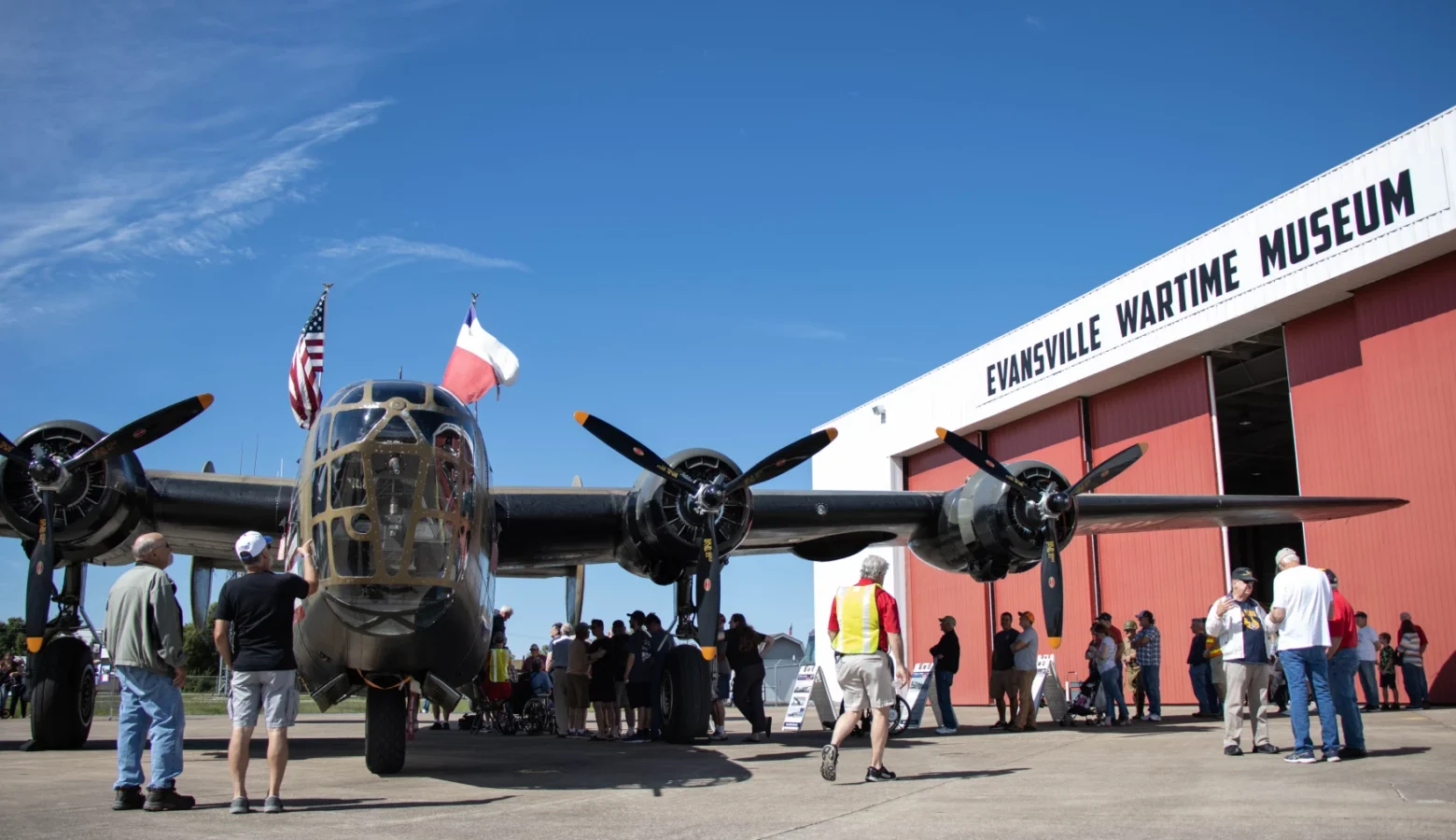‘Experiential learning’ key to keeping WWII history education alive as veteran voices dwindle

Army Air Corps Veteran John Birkhead of Evansville is 98 years old.
He stands with his son Jim behind the fence of the Evansville Wartime Museum, watching a WWII era B-24 bomber taxi up to the museum hangar, as other guests to the event take photos of the brown behemoth.
Despite being shot down in one of these planes in 1944, Birkhead still wants to see them every chance he gets.
“It’s a part of my life, an interesting part because I just almost didn’t survive it,” he said. “We got hit and we were flying about 24,000 feet. And we did our mission. And we got hit and we’re on fire and the plane blew up and I came out.”
Birkhead didn’t have to jump — he said the plane “blew apart” around him. He parachuted to safety, only to become a prisoner of war (POW) in Germany for a few months.
On this day in late September, a few WWII-era planes were flown in for the sake of sharing history — history visitors can actually step into.
Reitz High School history teacher Jon Carl thinks that “experiential” learning is key for his students to learn about historic eras such as World War two.
His standard curriculum includes digesting events and leaders from the era and discussing what drew the U.S. into the war. It’s rather broad, he said.
“They react better than to a textbook and a worksheet … I love trying to put things in the kids’ hands, objects that connect them to the historic events.”
In his case, photos of the Ohio River viewed from the same vantage point where the photo of a world war two shipyard was taken.

Carl holds the photo which contains elements such as docks from the WWII era shipyard that in part, still exists today. (Tim Jagielo / WNIN)
He uses newspaper clippings from the era as well. Of course, nothing beats actually climbing into a B-24 bomber.
These planes are owned and operated by non-profit organization Commemorative Air Force (CAF) with the tagline “The World’s Largest Flying Museum.”
CAF member Jim Dawson is wearing a flight jumpsuit seated in a mesh-and frame chair in the narrow underbelly of the B-24 bomber. He’s guiding guests a few at a time in and out of the B-24.
“All right, you ready to bail out? Okay, mission accomplished. Mission accomplished. So if you had to bail out you would go with that top hatch all the top …”
The inside is cramped — there is more room in a minivan and the structure is light and thin to save weight for the bombs.
Dawnson says visitors tell him that “they had no idea how people got in here and what they went through,” he said.
“And when we have the time of course we explain what they went through. Of course it was not uncommon to have a 22-year-old chief pilot on any of these aircraft during World War Two. And if you live to be mid 20s late 20s You’re really an old guy.”
Kevin is an aviation buff and got to fly in the CAF’s other bomber, a B-29. The cool factor of warplanes aside, the significance of his age is not lost on him.
“They were getting drafted at 17-18 years old, straight out of high school, and they had to go fly these 1214 hour combat missions,” Kevin said. “So it’s really hard to just put yourself in the shoes of those guys; they stepped up to the plate and really helped save the country and then in the long, run the world. So it was just I have massive respect for those guys.”
John Birkhead would have been right around 20 years old when he was shot down.
History teacher Jon Carl says he’s had to adjust his lessons on the war. He used to instruct his students to go talk to their grandparents about WWII, but he can’t usually do this anymore.
“As we’ve gotten farther away from World War 2, the kids don’t have grandparents anymore that fought in it,” he said. “They might have grandparents that talk about experiencing World War 2 as a child, but as we get farther and farther away, the kids don’t have those natural connections.”
Carl also tries to illustrate that it would have been them — or a sibling — soon going off to war.
“… as a junior sitting in an AP class or a freshman 15-years-old, is sitting in a regular US history class — their older brothers would have been going (to war) or they may have been the ones making the decision to go. So I try to bring that home.”

Teacher Jon Carl shares this image of resident Arlin McRae, who passed away in 2020. He asks students to guess his age — while he was a teenager at the time — not much older than them — they tend to guess he’s much older. McRae was an EVSC administrator and teacher, and had frequently shared his war stories with students. (Photo: EVSC)
It’s not difficult to do, considering most of the residents were involved in the war effort according to Mark Browning chairman of the wartime museum.
“Evansville was so important in World War 2, where the highest per capita population went for the war effort in the world,” he said. “80,000 out of 120,000 people that lived here, worked for the war effort.”
World War 2 veteran John Birkhead actually lived history. And despite its trauma — leaping to safety and being a prisoner of war — he still seeks to relive it through looking at these planes whenever he can.
“You know that song ‘Unforgettable?’ Well, that would apply to the situation like that — ‘unforgettable.’”

